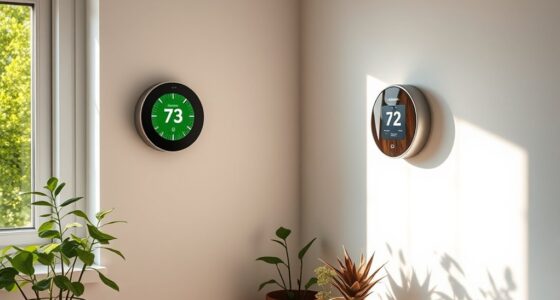To save energy with a varying family schedule, use smart thermostats to adapt temperature settings when no one is home or during sleep, and run appliances like dishwashers and laundry during off-peak times. Unplug devices when not in use and switch to LED bulbs to cut waste. Manage your home’s climate remotely and set routines for turning off electronics to keep energy bills low. Keep exploring for more effective ways to balance your schedule and save energy effectively.
Key Takeaways
- Install smart thermostats to automatically adjust temperatures based on family routines and occupancy patterns.
- Schedule heavy appliance use during off-peak hours to reduce energy costs and demand.
- Use energy-efficient appliances with high ENERGY STAR ratings to minimize energy consumption across the household.
- Implement small lifestyle habits like unplugging devices and switching to LED bulbs to prevent phantom energy waste.
- Manage household climate remotely and update appliances regularly to optimize energy savings for varying schedules.

Saving energy not only lowers your utility bills but also helps protect the environment. As a family with varying schedules, managing energy use can seem challenging, but simple adjustments can make a significant difference. One of the most effective tools you can leverage is a smart thermostat. These devices learn your family’s routines and adjust your home’s temperature accordingly, ensuring you’re not wasting energy when you’re away or asleep. For example, when everyone leaves in the morning or late at night, the smart thermostat can automatically lower the heating or cooling, saving energy without you having to remember to do it manually. Additionally, many smart thermostats allow you to control your home’s climate remotely via your smartphone, giving you the flexibility to optimize energy use even when you’re not home.
Smart thermostats help families save energy by adjusting temperatures automatically and remotely.
Another way to boost your home’s energy efficiency is by investing in energy-efficient appliances. These appliances consume less power while delivering the same performance, which is especially important for families with busy schedules. For instance, energy-efficient refrigerators and washing machines not only cut down on electricity bills but also reduce your home’s overall energy demand. When shopping for new appliances, look for those with high ENERGY STAR ratings—they’re tested and certified to meet strict energy efficiency standards. By replacing older, less efficient appliances, you can steadily decrease your household’s energy consumption over time.
In addition to smart thermostats and energy-efficient appliances, you should consider timing your energy use strategically. Since family members have different schedules, it’s smart to run heavy appliances like dishwashers or laundry machines during off-peak hours. Many utility companies offer incentives for shifting energy use to times when demand is lower, which can further reduce your costs. You can also set routines or reminders to turn off lights and electronics when they’re not in use, ensuring you’re not wasting energy unnecessarily.
Furthermore, making small lifestyle adjustments can have a big impact. Encourage family members to unplug devices when they’re not in use, as many electronics draw power even when turned off. Installing LED bulbs instead of traditional incandescent bulbs is another simple switch that reduces electricity use. These bulbs last longer and consume a fraction of the energy, which is perfect for households with varying schedules where lights may be left on for extended periods. Incorporating energy-saving tips like these can significantly enhance your overall household efficiency.
Frequently Asked Questions
How Can I Monitor Energy Usage Remotely?
You can monitor your energy usage remotely by installing smart meters and using energy apps. Smart meters provide real-time data on your consumption, which you can access through compatible apps on your smartphone or tablet. These tools allow you to track patterns, identify high-energy appliances, and make adjustments to save power, all from anywhere. This way, you stay in control and optimize your energy use even when schedules vary.
What Are the Best Smart Devices for Energy Saving?
You should consider smart thermostats and energy monitoring apps as the best devices for energy saving. Smart thermostats help you optimize heating and cooling, saving energy when you’re not home or during off-peak hours. Energy monitoring apps give you real-time insights into your usage, so you can identify waste and adjust accordingly. Together, these devices empower you to control your energy consumption efficiently, saving money and reducing your environmental impact.
How Do I Assess My Home’s Insulation Effectiveness?
Think of your home’s insulation as a cozy blanket, keeping warmth in and cold out. To assess its effectiveness, check for drafts around windows and doors. Inspect insulation materials in your attic and walls for signs of wear or gaps. Consider a professional thermal efficiency assessment; they use infrared cameras to spot heat leaks. Improving insulation can dramatically boost your home’s comfort and energy savings.
Are There Eco-Friendly Energy Sources Suitable for Families?
You can definitely consider eco-friendly energy sources like solar power and wind energy for your family. Installing solar panels helps you harness sunlight to generate electricity, reducing reliance on non-renewable sources. If you have space, wind turbines can also produce clean energy. Both options lower your carbon footprint, save you money over time, and contribute to a healthier environment. Explore local programs or incentives that make switching easier and more affordable.
How Can I Educate Kids About Energy Conservation?
You can teach kids about energy conservation by making it fun and engaging. Did you know that kids who learn about energy awareness are 50% more likely to adopt eco-friendly habits? Use simple explanations, involve them in activities like turning off unused lights, and share interesting facts. Encourage questions and praise their efforts to foster a sense of responsibility. Your active involvement helps instill lifelong energy-saving habits in your children.
Conclusion
By embracing these energy-saving tips, you’re planting seeds of change that grow into a greener, more sustainable home. Even with a busy schedule, every small action is like a drop of water nourishing the Earth’s roots. Remember, your efforts ripple outward, creating waves of impact beyond your household. Together, you can turn your home into a beacon of conservation, shining brightly and inspiring others to follow your lead—because a brighter future starts with your mindful choices today.








